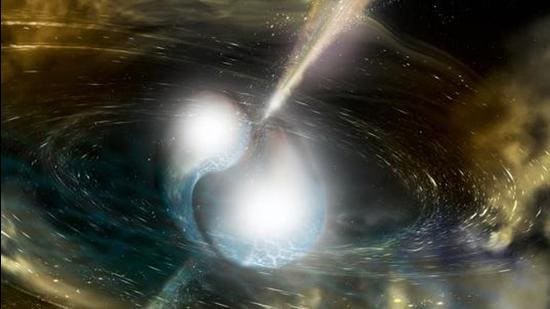Researchers observe never before seen short gamma-ray burst from collapsing star
Astronomers believe that short gamma-ray bursts of less than two seconds originate when two black holes, two neutron stars, or a black hole and a neutron star merge with each other
Astronomers from across the world, including those from four Indian institutions, observed a 0.65 second gamma-ray burst (GRB) in August last year using NASA’s Fermi Gamma-ray space telescope. The high-energy gamma-ray burst that has been travelling towards Earth for half of the present age of the universe was picked up by several instruments. Researchers were able to pinpoint its location.

What was unexpected was a supernova found at the origin of the gamma-ray burst for the first time.
Astronomers believe that short gamma-ray bursts of less than two seconds originate when two black holes, two neutron stars, or a black hole and a neutron star merge with each other. The long gamma-ray bursts were thought to originate from a massive star collapsing at the end of its life.
“A supernova is never formed during a merger; it is formed when a massive star collapses. This observation completely challenges the traditional classification of gamma-ray bursts; there is a need to relook all the bursts observed so far,” said Shashi Bhushan Pandey of the Aryabhatta Research Institute of Observational Sciences.
Also Read | Jeff Bezos offers NASA a $2 billion discount for Blue Origin Moon lander
Pandey was one of the Indian astronomers to participate in the study.
The study challenges two notions – not all short-duration gamma-ray bursts observed so far might have originated from a merger and not all collapsing massive stars end up producing long duration gamma rays. It helps resolve a long-standing puzzle in astronomy – there is a far greater number of supernovae than there are long gamma-ray bursts.
“We already knew some GRBs from massive stars could register as short GRBs, but we thought this was due to instrumental limitations. Now we know dying stars can produce short bursts, too,” said Bin-bin Zhang of Nanjing University in China and the University of Nevada, Las Vegas.
The researchers believe this particular gamma-ray burst, named GBR200826A, almost did not occur. “We think this event was effectively a fizzle, one that was close to not happening at all. Even so, the burst emitted 14 million times the energy released by the entire Milky Way galaxy over the same amount of time, making it one of the most energetic short-duration gammas-ray bursts ever seen,” said Tomás Ahumada, a doctoral student at the University of Maryland and NASA’s Goddard Space Flight Centre.
When a massive star reaches the end of its life, a black hole starts forming at its centre that sends out jets of particles at near-light speed. When the particles breach the surface of the earth, gamma-ray bursts are observed. “If this piercing does not happen properly, we would not observe a burst at all or we might observe a short burst. Now, we need to relook the data of the existing GRBs,” said Pandey.
“Of the overall known population, two-thirds are long duration and one third are short. Now, the massive stars are supposed to be found in the star-forming region of the galaxies whereas the merger events should be on the outskirts. But there have been instances of short duration GRB from the star-forming regions; those could be an instance such as this.”





